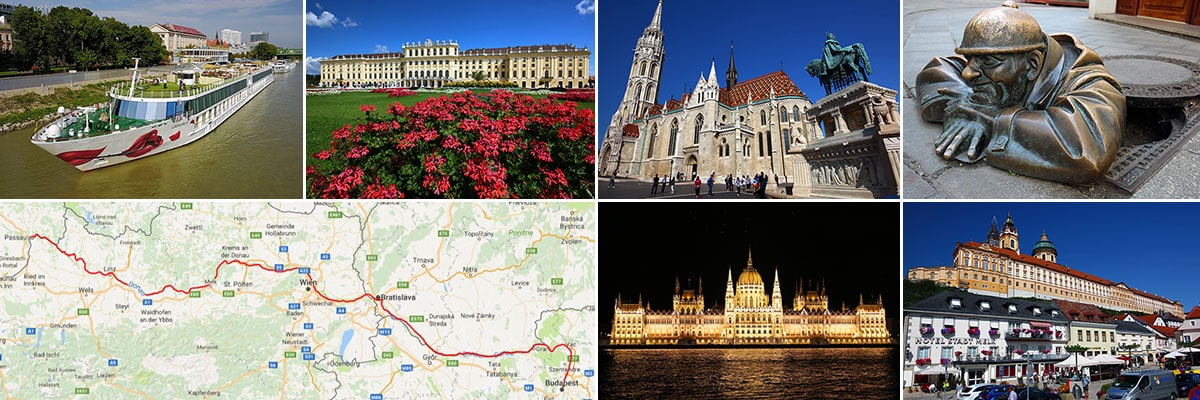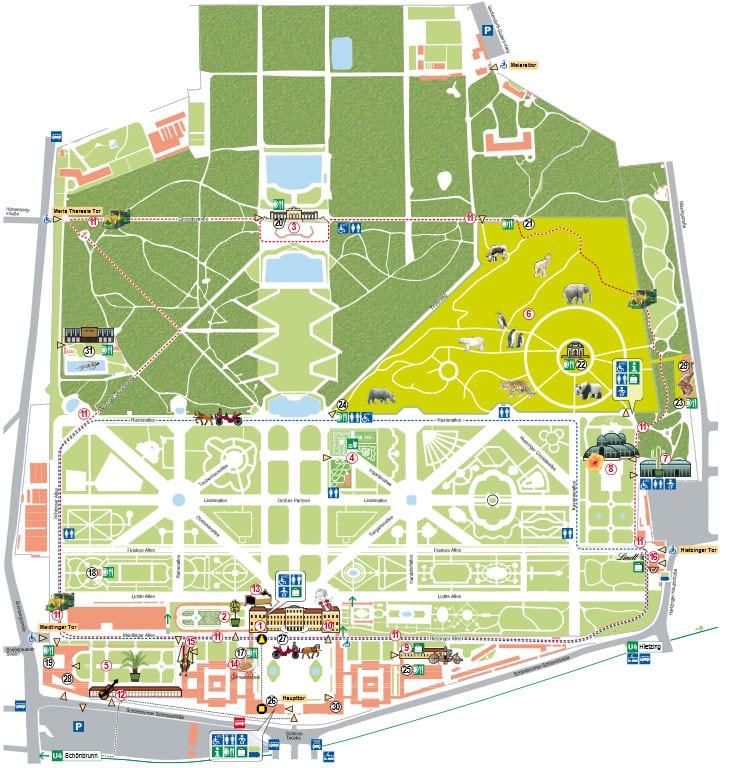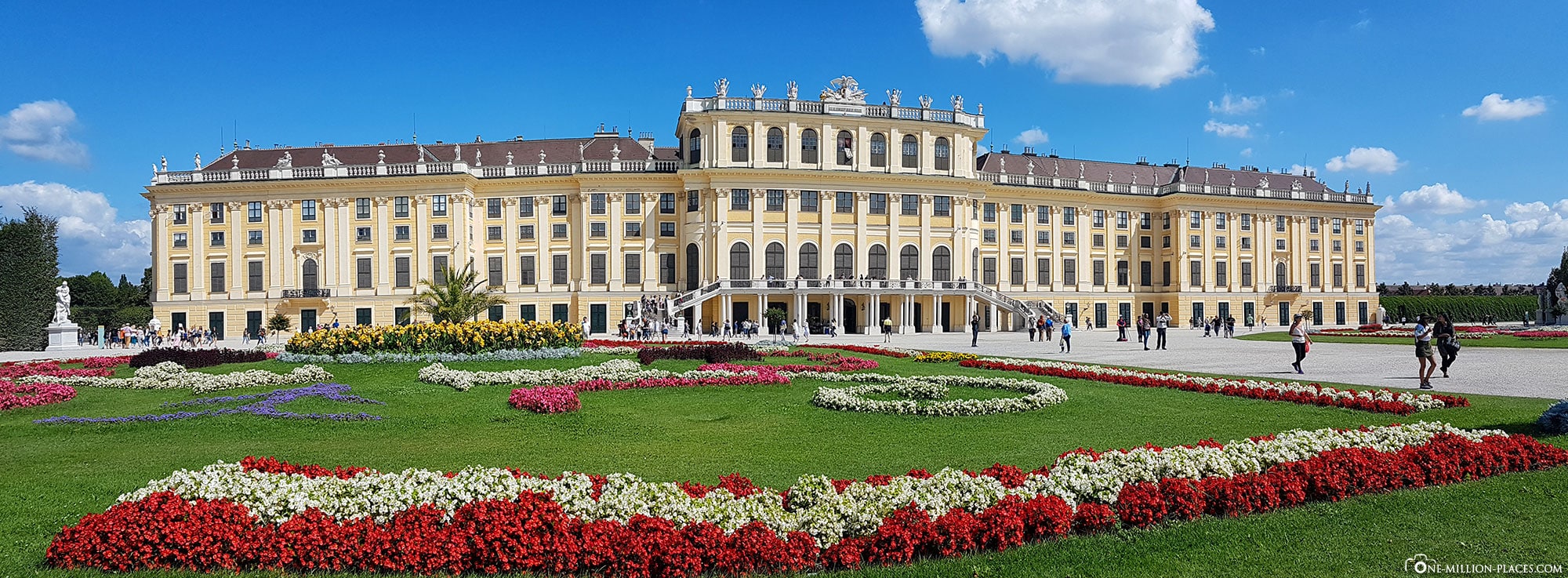After looking mainly at the sights of Vienna’s city centre on the first day, we used our 2nd day in Vienna to take a look at the other landmarks of the city. Since the weather was perfect on our two days, we mostly walked and used almost no public transport.

Table of contents
The Prater with the Vienna Ferris Wheel
When we speak of Prater at this point, we do not mean the entire 6 km2 recreation area, but the so-called “Wurstelprater”, i.e. the well-known Viennese amusement park. We were here on Sundays and accordingly the park was quite crowded – many families were on the way but also a lot of tourists. THE landmark and most photographed ride in the Prater is certainly the Vienna Ferris Wheel, which has been doing its laps since 1897. For a ticket you pay 10 euros per person. If it is to be a little more exclusive, you can also afford a candlelight dinner for a paltry 345 euros. A nice overview map of the Prater area can be downloaded here.
The HundertwasserHaus in Vienna
No straight lines, colourful colours, golden onion towers, green roof terraces and no right angles – definitely the trademark of Friedensreich Hundertwasser, the Viennese-born painter and artist. What was new for us was that his complete stage name Friedensreich Regentag Was Dunkelbunt Hundertwasser. You have to come up with something like that 😉
In his hometown there is probably one of his most famous “works”: The Hundertwasserhaus in Löwengasse houses 52 apartments, 4 shops and several roof terraces. On a sunny, almost cloudless summer day definitely a tourist magnet. The Hundertwasser area also includes the nearby Hundertwasser Village, a kind of visitor centre with shops and cafés, which is designed bazar-like. About 400 meters from the HundertwasserHaus is the Kunst Haus Wien, which was also built in Hundertwasser design. Here you can admire a Hundertwasser permanent exhibition as well as various temporary exhibitions.
There are about 40 buildings around the world, which are designed by Hundertwasser – including many in Germany.
Belvedere Castle
The Belvedere Palace certainly lives up to its name: the beautiful view is here, including 🙂
Due to its location on a rising slope, the castle ensemble consists of an Upper Belvedere and a Lower Belvedere. We first walked along Prinz-Eugen-Straße and walked into the park from above, so that we could walk from top to bottom towards the city through the castle and park. The two Belvedere castles were built at the beginning of the 18th century and are among the most beautiful baroque buildings in Europe with their gardens. The garden is beautifully planted and invites you to linger on beautiful summer days. Today, the castle’s buildings are home to the most important collection of Austrian art from the Middle Ages to the present day, as well as changing exhibitions about Austrian art in an international context.
Schönbrunn Palace
A visit to Sissi’s Schönbrunn Palace is of course not to be missed during a sightseeing tour in Vienna. With the u-bahn line U4 you can easily get here from Stephansplatz in a few minutes and walk from the stop only a few minutes to the entrance of the castle complex. All the coaches we saw on the way there have already made us suspect that the facility is overcrowded with tourists. But since we were less interested in the interiors and museums and only wanted to look at the castle complex and the 160 ha park, it went quite well.
Schönbrunn Palace was originally built as an imperial residence between 1638 and 1643, but was badly damaged during the Turkish siege. This was followed by the construction of a hunting lodge, which was never completed. As part of a major reconstruction from 1745, a representative imperial summer residence was built. Schönbrunn Palace became the cultural and political centre of the Habsburg Empire during this period. Today Schönbrunn is the largest castle in Austria and was declared a UNESCO World Heritage Site in 1996. It is definitely worth climbing the green hill of the park up to the Gloriette, because from up here you have a breathtaking view of the long-stretched sun-yellow baroque palace Schönbrunn with Vienna in the background.
According to the pedometer of our Samsung Gear watch, we walked almost 48,000 steps through Vienna over the 2 days, which is just over 30 kilometers 🙂
Starbucks Global Icon City Mug of Vienna
We are collecting the Starbucks Mugs from the cities and islands we visit on our travels. Unfortunately, not every city that has a Starbucks store with an own mug. But if the city has an own mug we like to collect them as a souvenir. We only collect city mugs from the "Global Icon Series", which was released in 2008. You can see our complete collection here: Starbucks - Our collection of Mugs from the Global Icon SeriesVienna of course has several Starbucks stores and also has its own cup 🙂
All travelogues from our Donau River Cruise
A-ROSA offers various river cruises on the Danube with different durations and destinations depending on the season. We had deliberately chosen the 7-day route "Danube Classic - On calm waters through the waves of European history", as this route connects the big metropolises (with sufficient mooring time), natural highlights and UNESCO world heritage sites - a perfect combination for us. The route with the "A-ROSA Bella" took us from Engelhartszell, via Vienna, Esztergom, Budapest, Bratislava and Melk back to Engelhartszell and Passau. » Austria: A-ROSA - 7 days river cruise on the Danube
» Austria: A-ROSA - 7 days river cruise on the Danube» Austria: Vienna – Tourist Attractions, Things to do & Photo spots
» Austriah: Vienna – Schönbrunn Palace, Belvedere Palace & Prater
» Hungary: Danube Knee, Esztergom, Visegrid and Szentendre
» Hungary: Budapest – Travel Guide & beautiful photo spots at night
» Hungary: Budapest – Tourist Attractions & Things to do on the Buda site
» Hungary: Budapest – Tourist Attractions & Things to do on the Pest side
» Slowakia: Bratislava – Tourist Attractions, Things to do & Photo spots
» Austria: Wachau – World Heritage Site on the Danube & Melk Abbey
» Germany: Passau - Tourist Attractions, Things to do & Photo spots


